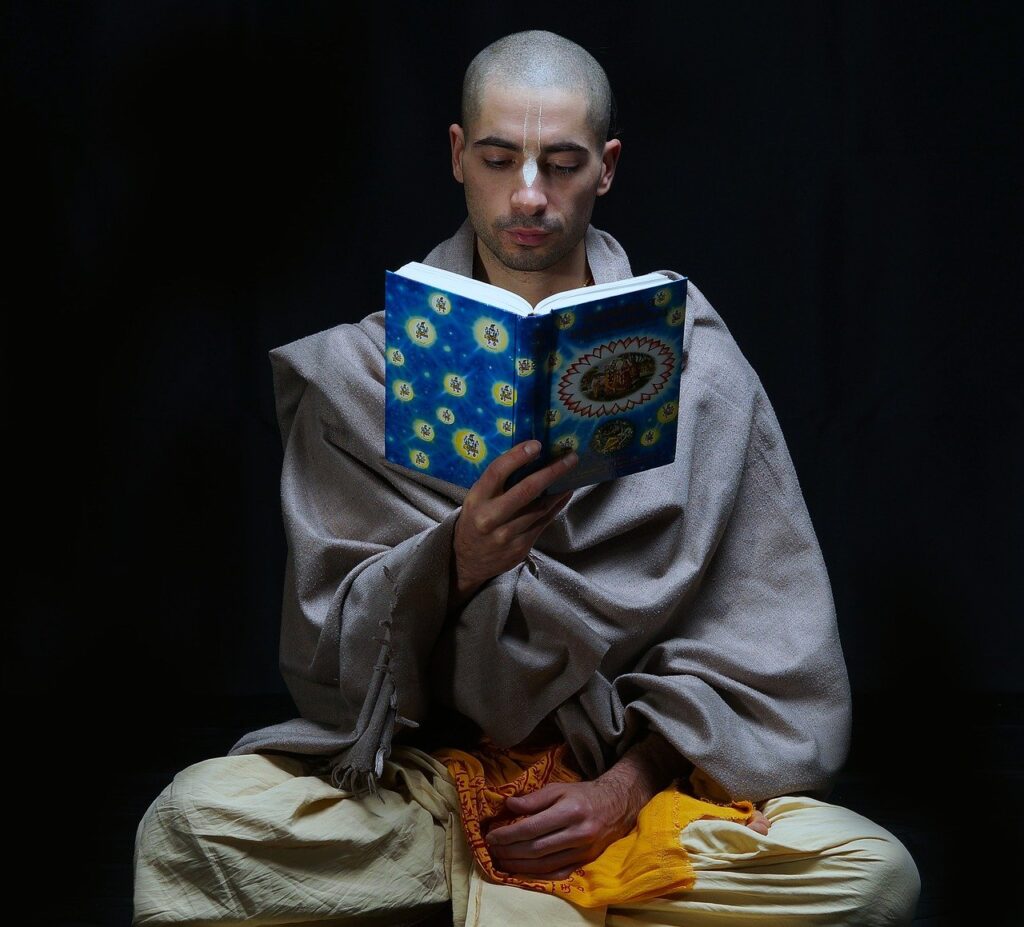
Yoga, contrary to popular opinion, does not refer to some impossible physical postures. The actual meaning of Yoga does not merely refer to bending, curving your body, or even holding your breath. The word yoga is derived from the Sanskrit root yuj, meaning “to yoke,” or “to unite”. The practice aims to create a union between body, mind, and spirit, as well as between the individual self and universal consciousness. The yoga system was originally meant for realizing God, and all varieties of yoga practice are assumed to bring one to that point. Success in Yoga ultimately depends on the quality of one’s consciousness and the will of the Supreme Person, rather than on our own gymnastic endeavors. The various yogic asanas, breath control, and withdrawal of the senses are meant to help pacify the mind so that one can focus one’s entire attention on the Supreme Lord (Paramatma) who is eternally present within our heart.
Ashtanga Yoga | Hatha Yoga
The practice of Yoga is based on the Patanjali Sutras, consisting of 194 aphorisms. They are divided into four sections – samadhi (trance), sadhana (practice), vibhuti (mystic powers), and kaivalya (ultimate aim). The Patanjali Yoga-Sutra, which is the foundational guidebook for Ashtanga yoga, explains that yoga in its completeness comprises eight stages and so is called ashtanga-yoga (ashta – eight, anga – limbs). The popular Hatha Yoga that we witness today, is related to the ‘asana’ stage of ashtanga yoga. The exercises in Patanjali’s system are designed not merely for physical health but to facilitate introspection and self-realization. The Patanjali system warns the yogi not to be allured to the mystic siddhis (perfections) but instead to focus on the goal of self-realization. This involves discrimination between matter and spirit, purging oneself of base qualities (lust, greed, illusion, etc), and having complete control over the mind and senses. Kaivalya refers to the realization that one is not the body but the soul within. It is achieved when the yogi is fixed in meditation on the Lord residing within the heart and no longer influenced by the three modes of material nature.

The eight stages of Yoga are –
- yama – do’s and the don’ts
- niyama – developing virtues
- asana – physical postures
- pranayama – breathing exercises
- pratyahara – sense withdrawal
- dharana – concentration
- dhyana – meditation
- samadhi – trance (absorption of the mind on one point)
What is today popularly known as yoga is actually just one of the eight stages of Ashtanga Yoga, namely ‘asana’. This discipline prepares the body to stay in various postures for long periods. The side effects include a healthy, lean body, but the real purpose is to gradually train the body to remain in the same position for hours, days, and eventually even months and years. Until one can sit in the lotus position for hours and days without shifting and being uncomfortable, one cannot, for example, successfully raise one’s Kundalini.
In the final stage of samadhi, the yogi pushes the soul out through the top of the skull and proceeds to wherever the consciousness is fixed at the moment. Pushing the soul up through the different chakras of the body and finally releasing it through the highest chakra at the top of the head is known as Kundalini rising.

Vedic texts reveal that the energy thus released is so immense that the body is sometimes consumed by fire. We learn from the Srimad-Bhagavatam that when King Dhritarashtra went to the forest to leave his body in this way, he initiated a forest fire. It was into this fire that his wife, Gandhari, and Queen Kunti, the mother of the Pandavas, entered together to gain release from their mortal bodies.
This type of yoga is excessively difficult to practice in the modern age. In this context, even Arjuna confessed that it is easier for him to control the wind than to control his own mind. The yogis of yore would go to the forest to practice ashtanga-yoga and leave their bodies. For spiritual perfection in the current age, Kali-yuga, the Vedic literature doesn’t recommend ashtanga-yoga, which is a harsh and severe practice.
Yoga in Bhagavad Gita
Bhagavad Gita, the crown jewel of Vedic scriptures, is a treasure for ‘yoga’ lovers. The holy scripture speaks about the detached way of life through its 700 ‘slokas’ divided into 18 chapters. These chapters also include an elaborate description of different types of ‘yoga’, which can help perfect one’s life. The 3 paths of Yoga, delineated in the Bhagavad Gita are –
#1 Karma Yoga (yoga of selfless action) – Karma-yoga begins with the realization that selfish action binds the soul. By giving up the results of action, one is relieved from the reactions to self-centered activities. This does not imply giving up the activity itself, for karma-yoga, but instead recommends linking all activities to a higher cause. Karma-yoga especially deals with offering various sacrifices to various deities to attain material benedictions in this life and the next, without accruing any reaction. On the highest level, karma-yoga means the unreserved dedication of all activities to serve the Supreme Lord. Karma-yogis tend to have a materially progressive attitude towards the world and their aim is often reaching the heavenly planets.

#2 Jnana Yoga (philosophical research and wisdom) – Jnana Yoga involves mental speculation, evaluating ideas, through logic and discourse, and aspiring to ultimately comprehend what is what. Jnana Yoga is the realization of the self through philosophical discussions. Jnana Yoga involves discrimination between matter and spirit through mental speculation. Hence Jnana Yoga promotes knowledge through seclusion, study, and sense abnegation. Activities and necessities of life are minimized in Jnana Yoga, as the focus is placed on becoming free from sensual desires that deceive the soul. By rejecting matter, Jnana Yogis aim at attaining liberation (moksha).
#3 Bhakti Yoga (Path of devotional service) – The process of reawakening the transcendental loving relationship between God and the living entity is called ‘Bhakti Yoga’. Bhakti or pure devotional service is free from all traces of Karma (fruitive activities) and Jnana (speculative knowledge). A devotee established in Bhakti Yoga, constantly serves the Lord, engaging his mind, intellect, and all of his senses in the Lord’s service. Bhakti Yoga purifies one and frees one from all material designations. Upon attaining pure love of God, one neither hankers nor laments. He is freed from all attachments and detachments and takes no pleasure in material things.

Bhakti (devotion) appears to be the path most recommended in the Bhagavad Gita. Krishna says that at the beginning, bhakti-yoga appears simple, but as it is perfected and as the practitioner matures, it combines all the other types of yoga. Bhakti includes the external and symbolic worship of the deity, other practices such as pilgrimage, and the sophisticated processes of inner development like mantra meditation. It has often been condescendingly presented as suitable to those with emotional rather than intellectual dispositions, but thinkers such as Ramanuja, Madhva, and Vallabha have refuted such claims. Their theologies emphasize the importance of developing bhakti based on spiritual knowledge. They also stress the importance of grace in achieving such spiritual knowledge, often received via the guru (spiritual master), the mediator of God’s mercy. Bhakti-yoga is sometimes considered the synthesis and ultimate goal of karma and jnana. The goals of many bhakti schools transcend both fruitive results and Mukti (liberation) and aim at pure, selfless service to the Supreme Lord.
Yoga and Love
Vedic texts that are the source of yoga explain that yoga has much more to offer than what we are currently receiving. In its most evolved form, yoga does much more than simply heal the body. The possibility goes far beyond even calming the mind. The highest form of yoga fulfills the need of our hearts. More than treasures and pleasures, positions and possessions, our deepest longing is for love. All of us want to love and to be loved. In our times, love is a much talked, little understood word. Often love is misunderstood to be the physical relationship between two people, but real love goes beyond the body, beyond the mind, to the real person, the spiritual being. True love enables us to connect with others in an eternal dimension by centering our relationship on the Supreme Lord who is the origin of all love.